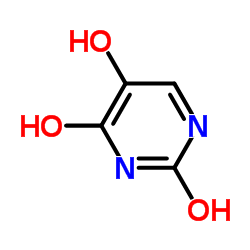5-hydroxyuracil

5-hydroxyuracil structure
|
Common Name | 5-hydroxyuracil | ||
|---|---|---|---|---|
| CAS Number | 496-76-4 | Molecular Weight | 128.086 | |
| Density | 1.8±0.1 g/cm3 | Boiling Point | 534.5±53.0 °C at 760 mmHg | |
| Molecular Formula | C4H4N2O3 | Melting Point | 300ºC | |
| MSDS | Chinese USA | Flash Point | 277.0±30.9 °C | |
| Symbol |

GHS07 |
Signal Word | Warning | |
|
Hydrolytic pathway of 5-fluorouracil in aqueous solutions for clinical use.
J. Pharm. Biomed. Anal. 98 , 446-62, (2014) The purpose of the study was to investigate the degradation pathway of 5-fluorouracil (FU) in the situation of commercial formulations for clinical use, namely FU dissolved in sodium hydroxide (NaOH) solutions or Tris buffer at pH 8.5-9. Combination of data f... |
|
|
Mutational analysis of the damage-recognition and catalytic mechanism of human SMUG1 DNA glycosylase.
Nucleic Acids Res. 32(17) , 5291-302, (2004) Single-strand selective monofunctional uracil-DNA glycosylase (SMUG1), previously thought to be a backup enzyme for uracil-DNA glycosylase, has recently been shown to excise 5-hydroxyuracil (hoU), 5-hydroxymethyluracil (hmU) and 5-formyluracil (fU) bearing an... |
|
|
Base-promoted reaction of 5-hydroxyuracil derivatives with peroxyl radicals.
Org. Lett. 12(18) , 4130-3, (2010) Addition of millimolar amounts of a weak base (pyridines) dramatically accelerates the reaction with peroxyl radicals of two biologically relevant uracil derivatives, 5-hydroxyuracil (HU) and 5-hydroxy-6-methyluracil (HMU). This is due to the formation of sma... |
|
|
NEIL1 is the major DNA glycosylase that processes 5-hydroxyuracil in the proximity of a DNA single-strand break.
Biochemistry 46(13) , 4158-63, (2007) 5-Hydroxyuracil (5-OHU) in DNA, arising during endogenous DNA damage and caused by ionizing radiation, is removed by the base excision repair pathway. However, in addition to base lesions, ionizing radiation also generates DNA single-strand breaks (SSBs). Whe... |
|
|
Substrate specific stimulation of NEIL1 by WRN but not the other human RecQ helicases.
DNA Repair (Amst.) 9(6) , 636-42, (2010) NEIL1, the mammalian homolog of Escherichia coli endonuclease VIII, is a DNA glycosylase that repairs ring-fragmented purines, saturated pyrimidines and several oxidative lesions like 5-hydroxyuracil, 5-hydroxycytosine, etc. Previous studies from our laborato... |
|
|
Modulation of DNA glycosylase activities in mesenchymal stem cells.
Exp. Cell Res. 315(15) , 2558-67, (2009) Adipose-tissue derived mesenchymal stem cells (AT-MSCs) are a promising tool for use in cell-based therapies. However, in vitro expansion is required to obtain clinically relevant cell numbers, and this might increase the chance of genomic instability. DNA re... |
|
|
DNA polymerase delta-dependent repair of DNA single strand breaks containing 3'-end proximal lesions.
Nucleic Acids Res. 35(4) , 1054-63, (2007) Base excision repair (BER) is the major pathway for the repair of simple, non-bulky lesions in DNA that is initiated by a damage-specific DNA glycosylase. Several human DNA glycosylases exist that efficiently excise numerous types of lesions, although the clo... |
|
|
Replication fork collapse is a major cause of the high mutation frequency at three-base lesion clusters.
Nucleic Acids Res. 41(20) , 9339-48, (2013) Unresolved repair of clustered DNA lesions can lead to the formation of deleterious double strand breaks (DSB) or to mutation induction. Here, we investigated the outcome of clusters composed of base lesions for which base excision repair enzymes have differe... |
|
|
Identification of a zinc finger domain in the human NEIL2 (Nei-like-2) protein.
J. Biol. Chem. 279(45) , 47132-8, (2004) The recently identified human NEIL2 (Nei-like-2) protein, a DNA glycosylase/AP lyase specific for oxidatively damaged bases, shares structural features and reaction mechanism with the Escherichia coli DNA glycosylases, Nei and Fpg. Amino acid sequence analysi... |
|
|
Base-pairing properties of the oxidized cytosine derivative, 5-hydroxy uracil.
Biochem. Biophys. Res. Commun. 366(3) , 752-7, (2008) The most abundant base-substitution mutation resulting from oxidative damage to DNA is the GC to AT transition mutation. 5-hydroxyuracil (5-OHU), produced by the oxidative deamination of cystosine, has been established as the major chemical precursor for this... |